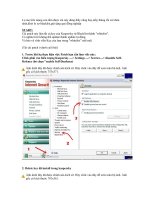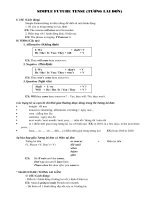KPMG 2018 IFRS update
Bạn đang xem bản rút gọn của tài liệu. Xem và tải ngay bản đầy đủ của tài liệu tại đây (5.49 MB, 273 trang )
2018 IFRS Update
October 2018
KPMG Lower Gulf Limited
kpmg.com/ae
kpmg.com/om
©
© 2018 KPMG Lower Gulf Limited and KPMG LLP, operating in the UAE and Oman, member firms of the KPMG network of independent member
firms affiliated with KPMG International Cooperative (“KPMG International”), a Swiss entity. All rights reserved.
1
What you
(probably)
missed in
IFRS 15, IFRS 9
and IFRS 16?
©
© 2018 KPMG Lower Gulf Limited and KPMG LLP, operating in the UAE and Oman, member firms of the KPMG network of independent member
firms affiliated with KPMG International Cooperative (“KPMG International”), a Swiss entity. All rights reserved.
2
IFRS Update – Disclaimer
September 2018
Whilst care has been taken in the preparation of this training
material, details may be omitted which may be directly relevant to a
particular entity. Reference to the standards and other authoritative
material should therefore be made, and specific advice sought, in
respect of any particular transaction. No responsibility for loss
occasioned to any person acting or refraining from action as a result
of anything in this training material can be accepted by KPMG.
This training material is based on standards, interpretations and
other authoritative material issued until the 31 August 2018.
Agenda
IFRS 15
Revenue from
contracts with
customers
IFRS 9
Financial
Instruments
IFRS 16
Leases
©
© 2018 KPMG Lower Gulf Limited and KPMG LLP, operating in the UAE and Oman, member firms of the KPMG network of independent member
firms affiliated with KPMG International Cooperative (“KPMG International”), a Swiss entity. All rights reserved.
4
IFRS 15
Agenda – IFRS 15
General
guidance
Practical
examples
Industry
considerations
Disclosures
©
© 2018 KPMG Lower Gulf Limited and KPMG LLP, operating in the UAE and Oman, member firms of the KPMG network of independent member
firms affiliated with KPMG International Cooperative (“KPMG International”), a Swiss entity. All rights reserved.
6
Why go through the process if change is not
big?
IAS
18
IAS
11
IAS
18
Revenue CUXXX
IFRS
15
IFRS
15
IFRS
15
Revenue may be only
CUXXX ± ~10%
The thought process changes even if the accounting doesn’t that much
Single comprehensive framework
Greater comparability
Important with evolving products and business
models
Judgments made within the framework
More useful information for investors (we will talk about these later…)
©
© 2018 KPMG Lower Gulf Limited and KPMG LLP, operating in the UAE and Oman, member firms of the KPMG network of independent member
firms affiliated with KPMG International Cooperative (“KPMG International”), a Swiss entity. All rights reserved.
7
What have we learnt
Clients underestimate the
impact of IFRS 15
Nobody has read the
‘terms and conditions’
5
outcomes
You may no longer
continue the use of the
Percentage of Completion
method
Revenues and cost do not
match anymore
©
© 2018 KPMG Lower Gulf Limited and KPMG LLP, operating in the UAE and Oman, member firms of the KPMG network of independent member
firms affiliated with KPMG International Cooperative (“KPMG International”), a Swiss entity. All rights reserved.
8
Revenue recognition – New 5 step model
Step
1
Identify the contract
Step
2
Identify performance obligations (PO) in
the contract
Step
3
Determine the transaction price (TP)
Step
4
Allocate the transaction price to
performance obligations
Step
5
Recognise revenue as performance
obligations satisfied
Contract
PO 1
PO 2
TP for the contract
TP allocated to
PO 1
TP allocated to
PO 2
Revenue on PO 1
Revenue on PO 2
©
© 2018 KPMG Lower Gulf Limited and KPMG LLP, operating in the UAE and Oman, member firms of the KPMG network of independent member
firms affiliated with KPMG International Cooperative (“KPMG International”), a Swiss entity. All rights reserved.
9
Identify the contract
... collection of
consideration is
considered probable.
Step
1
... rights to goods or
services and payment
terms can be identified.
A contract
exists if...
... it has commercial
substance.
... it is approved and the
parties are committed to
their obligations.
©
© 2018 KPMG Lower Gulf Limited and KPMG LLP, operating in the UAE and Oman, member firms of the KPMG network of independent member
firms affiliated with KPMG International Cooperative (“KPMG International”), a Swiss entity. All rights reserved.
10
Identify performance obligations in the
contract
Step
2
A performance obligation (PO) is a promise to deliver a good
or service that meets both the following criteria
Criterion 1: Can the customer
benefit from the good or
service either on its own or
together with other resources
that are readily available to the
customer?
Yes
Distinct performance
obligation
Criterion 2: Is the promise to
transfer the good or service
separately identifiable from
other promises in the contract?
No
Not distinct – combine with
other goods and services
©
© 2018 KPMG Lower Gulf Limited and KPMG LLP, operating in the UAE and Oman, member firms of the KPMG network of independent member
firms affiliated with KPMG International Cooperative (“KPMG International”), a Swiss entity. All rights reserved.
11
Determine the transaction price
Step
3
Consideration payable to a
customer
…reduction to the transaction
price unless it’s a payment for
a distinct good or service.
Variable consideration and
the constraint
Transaction
price
Non-cash consideration
…measured at fair value
unless it cannot be reliably
measured.
Significant financing
component
©
© 2018 KPMG Lower Gulf Limited and KPMG LLP, operating in the UAE and Oman, member firms of the KPMG network of independent member
firms affiliated with KPMG International Cooperative (“KPMG International”), a Swiss entity. All rights reserved.
12
Variable consideration
Step
3
Variable consideration can be
Discounts
Liquidated damages
Incentives
Performance bonuses
Penalties on product’s or
service’s performance
©
© 2018 KPMG Lower Gulf Limited and KPMG LLP, operating in the UAE and Oman, member firms of the KPMG network of independent member
firms affiliated with KPMG International Cooperative (“KPMG International”), a Swiss entity. All rights reserved.
13
Variable consideration – the amount to
include
Step
3
Is the consideration variable or fixed?
VARIABLE
FIXED
Estimate the amount using the expected value or most likely amount
Determine the portion, if any, of that amount for which it is highly
probable that a significant revenue reversal will not subsequently occur
Include the amount in the transaction price
©
© 2018 KPMG Lower Gulf Limited and KPMG LLP, operating in the UAE and Oman, member firms of the KPMG network of independent member
firms affiliated with KPMG International Cooperative (“KPMG International”), a Swiss entity. All rights reserved.
14
Variable consideration
Estimate transaction
price
— Expected value or
— Most likely amount
— update each period
Step
3
Apply constraint
— Highly probable no
significant revenue reversal
— 5 indicators
Does this mean that assuming CU0 is a valid default?
©
© 2018 KPMG Lower Gulf Limited and KPMG LLP, operating in the UAE and Oman, member firms of the KPMG network of independent member
firms affiliated with KPMG International Cooperative (“KPMG International”), a Swiss entity. All rights reserved.
15
Significant financing component
Significant
financing
component
Step
3
— Transaction price compared to cash selling price.
— Period between payment and delivery.
— Other reasons for payment terms.
Discount
rate
— Rate that would be used in separate financing
transaction between the entity and customer.
Practical
Expedient
— No adjustment required if the period between
performance and payment is 12 months or less.
©
© 2018 KPMG Lower Gulf Limited and KPMG LLP, operating in the UAE and Oman, member firms of the KPMG network of independent member
firms affiliated with KPMG International Cooperative (“KPMG International”), a Swiss entity. All rights reserved.
16
Allocate the transaction price to POs
Step
4
Allocate based on relative stand-alone selling prices
Performance obligation 1
Performance obligation 2
Performance obligation 3
Determine stand-alone selling prices
Best evidence
If not available
Observable price
Estimate price
Adjusted market assessment
approach
Fair value measurement
Expected cost plus a margin
approach
Residual approach only if selling price is
highly variable or uncertain
©
© 2018 KPMG Lower Gulf Limited and KPMG LLP, operating in the UAE and Oman, member firms of the KPMG network of independent member
firms affiliated with KPMG International Cooperative (“KPMG International”), a Swiss entity. All rights reserved.
17
Over time or at a point in time?
Measurement
principle
Step
5
An entity recognises revenue when or as
it satisfies a performance obligation by
transferring a good or service to a
customer, either at a point in time (when)
or over time (as). A good or service is
transferred when or as the customer
obtains control of it.
©
© 2018 KPMG Lower Gulf Limited and KPMG LLP, operating in the UAE and Oman, member firms of the KPMG network of independent member
firms affiliated with KPMG International Cooperative (“KPMG International”), a Swiss entity. All rights reserved.
18
Recognize revenue as POs satisfied
Step
5
A performance obligation is satisfied over time if either:
1
2
3
Customer simultaneously receives and consumes
the benefits as the entity performs.
Routine or recurring
services
e.g. cleaning services
The customers controls the asset as the entity
creates or enhances it.
Construction on
customer’s land;
customer controls the
work in progress
The entity’s performance does not create an asset
for which the entity has an alternate use and there
is a right to payment for performance to date.
Building a specialised
asset that only customer
can use or building an
asset to customer
specifications
©
© 2018 KPMG Lower Gulf Limited and KPMG LLP, operating in the UAE and Oman, member firms of the KPMG network of independent member
firms affiliated with KPMG International Cooperative (“KPMG International”), a Swiss entity. All rights reserved.
19
Recognise revenue as POs satisfied
Step
5
If a performance obligation is not satisfied over time, then an entity
recognizes revenue at the point in time at which it transfers control of the
good or service to the customer.
Indicators that control has passed include a customer having …
… a present
obligation to
pay
… accepted
the asset
… legal title
… physical
possession
… risks and
rewards of
ownership
©
© 2018 KPMG Lower Gulf Limited and KPMG LLP, operating in the UAE and Oman, member firms of the KPMG network of independent member
firms affiliated with KPMG International Cooperative (“KPMG International”), a Swiss entity. All rights reserved.
20
Step 5: Points for consideration
Which method to measure
progress of revenue is more
appropriate – either input or
output method.
Do you have enforceable
rights to payments by
assessing termination clauses,
reviewing legal precedence
and determining whether you
have the right to sue for
performance?
©
© 2018 KPMG Lower Gulf Limited and KPMG LLP, operating in the UAE and Oman, member firms of the KPMG network of independent member
firms affiliated with KPMG International Cooperative (“KPMG International”), a Swiss entity. All rights reserved.
21
Contract costs – What’s changed?
IAS 11
IFRS 15
— Acceptable to measure
revenues and costs applying
POC with balance sheet
‘true up’.
— No automatic link between
revenue and cost.
— Costs incurred that relate to
satisfied or partially satisfied
performance obligation are
expensed as incurred.
©
© 2018 KPMG Lower Gulf Limited and KPMG LLP, operating in the UAE and Oman, member firms of the KPMG network of independent member
firms affiliated with KPMG International Cooperative (“KPMG International”), a Swiss entity. All rights reserved.
22
Contract costs
Acquire a
contract
Fulfilment costs
Do IAS 2, IAS
16 or IAS 38
apply?
Capitalise if
incremental
(except if
contract
duration < or =
12 months)
Capitalise or
expense
Apply
IFRS 15
©
© 2018 KPMG Lower Gulf Limited and KPMG LLP, operating in the UAE and Oman, member firms of the KPMG network of independent member
firms affiliated with KPMG International Cooperative (“KPMG International”), a Swiss entity. All rights reserved.
23
Pre-contract costs
Would costs be incurred
regardless of whether the
contract is obtained?
No
Yes
Yes
Do they meet the criteria to
be capitalised as fulfillment
costs?
Are the incremental costs
expected to be recovered?
Yes
No
Capitalise costs
No
Expense costs as they are
incurred
As a practical expedient, capitalisation of contract acquisition costs not
required if the amortisation period would be one year or less.
©
© 2018 KPMG Lower Gulf Limited and KPMG LLP, operating in the UAE and Oman, member firms of the KPMG network of independent member
firms affiliated with KPMG International Cooperative (“KPMG International”), a Swiss entity. All rights reserved.
24
Costs to fulfil a contract
Direct costs that are eligible for
capitalisation if other criteria are
met
Direct labour (e.g. employee wages)
Costs to be expensed when
incurred
General and administrative costs –
unless explicitly chargeable under the
contract
Direct materials (e.g. supplies)
Allocation of costs that relate directly
to the contract (e.g. depreciation and
amortisation)
Cost that are explicitly chargeable to
the customer under the contract
Other costs that were incurred only
because the entity entered into the
contract (e.g., subcontractor costs)
Costs that relate to satisfied
performance obligations
Costs of wasted materials, labour, or
other contract costs
Costs that do not clearly relate to
unsatisfied performance obligations
©
© 2018 KPMG Lower Gulf Limited and KPMG LLP, operating in the UAE and Oman, member firms of the KPMG network of independent member
firms affiliated with KPMG International Cooperative (“KPMG International”), a Swiss entity. All rights reserved.
25









